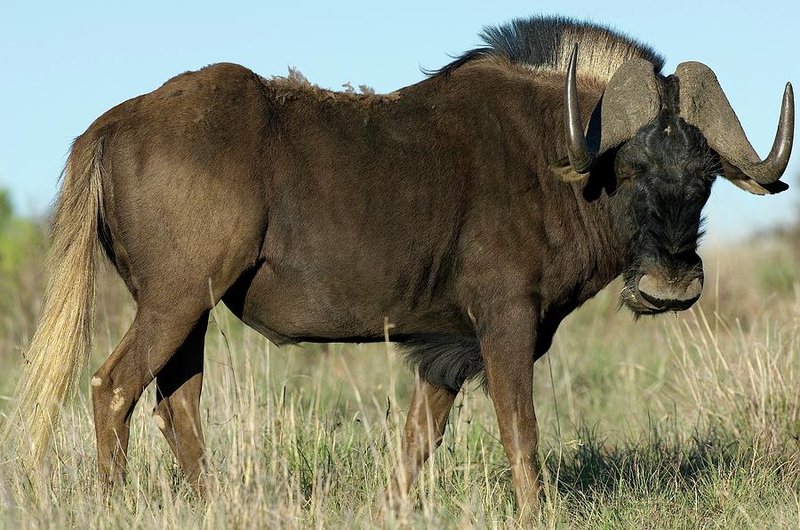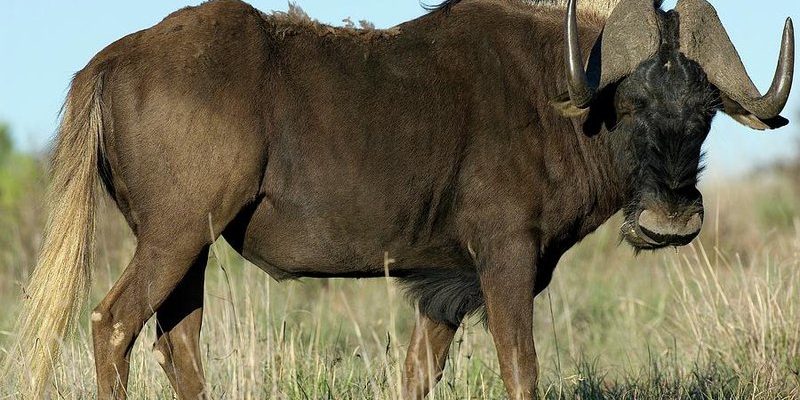
Have you ever seen a creature that looks like a wild combination of an antelope and an artist’s paintbrush? That’s the Black Wildebeest for you! With its unique appearance and lively behavior, it captures the hearts of wildlife enthusiasts and casual observers alike. These animals, native to South Africa, are not just fascinating because of their looks—they also play a vital role in their ecosystem.
Imagine wandering through the savannas, and suddenly, you spot a herd of these wild beauties galloping across the landscape. Their distinctive curved horns and striking dark coats make them stand out. But there’s more to them than just appearances. Their social behavior, feeding habits, and survival strategies are intriguing aspects that reveal how these creatures thrive in the wild.
Physical Characteristics
The Black Wildebeest, also known as the white-tailed gnu, has a physique that’s both sturdy and graceful. Males are generally larger than females, standing about 1.2 meters tall at the shoulder. Their weight ranges from 160 to 270 pounds, depending on factors like age and habitat. One of their most remarkable features is their long, curved horns. Male horns can grow up to 80 centimeters, giving them an impressive look.
These animals are easily recognized by their long, shaggy black coats. Females are lighter, displaying a brownish hue which helps them blend into their surroundings, especially when caring for their young. The contrast between males and females is striking—almost like nature’s way of creating a visual harmony in the wild.
Another interesting aspect is their unique tail, which ends in a fluffy white tuft. When the Black Wildebeest kicks its tail, it signals excitement or stress, providing a glimpse into the animal’s emotional state. Their sharp eyesight and keen sense of smell are essential tools for spotting predators lurking nearby.
Habitat and Distribution
The Black Wildebeest primarily inhabits the grassy plains and savannas of South Africa, particularly in areas like the Free State and Gauteng provinces. These environments provide an abundance of grass, which forms the core of their diet. However, they can also adapt to various settings, including semi-arid regions.
Interestingly, their habitat preferences play a critical role in their survival. They thrive in open landscapes where they can easily spot predators from a distance. This keen awareness helps them navigate the challenges posed by lions, hyenas, and other predators that frequent their territory.
As you explore these regions, you may notice their preference for habitats with accessible water sources. The Black Wildebeest typically moves toward water bodies during hot days to hydrate and cool down. This behavior highlights their adaptability and understanding of their environment, making them experts at survival in the wild.
Diet and Feeding Habits
The diet of the Black Wildebeest is largely composed of grasses and forbs, which provide essential nutrients. It’s fascinating to think of them as natural lawnmowers, continuously grazing and keeping the grasslands healthy. They have a grazing pattern that helps maintain their habitat, promoting new growth and ensuring biodiversity.
Interestingly, these wildebeests have adapted to browse on tougher vegetation during dry seasons when grass is scarce. This flexibility in their diet ensures they can survive through challenging conditions. They are also social grazers, often feeding in groups to ensure safety in numbers while looking out for potential threats.
Another aspect to consider is how their feeding habits impact other species in their ecosystem. By grazing on specific types of grasses, they create space for other plants to grow, ensuring a rich and diverse habitat for various animals and insects. This interconnectedness is a beautiful illustration of how one species contributes to the larger ecosystem.
Behavior and Social Structure
The Black Wildebeest is known for its fascinating social structure and behavior. They are incredibly social animals, often forming herds that can range from a few individuals to over a hundred. Living in groups provides safety in numbers—an important survival strategy against predators in the wild.
Within these herds, males engage in playful sparring to establish dominance and attract females during the mating season. These displays are not just physical contests; they are a crucial part of their social behavior. Males use their impressive horns and agility to demonstrate strength, which plays a significant role in their reproductive success.
You might be surprised to learn that their social interactions extend beyond mere competition. The Black Wildebeest exhibits nurturing behaviors as well. Mothers are attentive to their young, often keeping them close and teaching them the ropes of survival. This strong bond between mother and calf further emphasizes the importance of social structures in the animal kingdom.
Reproduction and Lifespan
The mating season for the Black Wildebeest typically occurs in late winter to early spring. Males compete fiercely for the attention of females, showcasing their strength and fitness. Once a female mates, she will have a gestation period of around 7 to 8 months, culminating in the birth of a single calf, although twins can occasionally occur.
Caring for the calf is no small task. The mother will often hide her young in tall grass, returning to nurse them at intervals. This protective behavior is crucial, as newborn wildebeests are vulnerable to various predators. They grow rapidly and are usually able to run with the herd by the time they are a few days old, making them less susceptible to attacks.
In the wild, the average lifespan of a Black Wildebeest is around 20 years, though some may live longer under favorable conditions. Their longevity is influenced by factors such as habitat quality, availability of food, and exposure to predators. Understanding their life cycle helps conservationists develop effective strategies to protect and preserve these remarkable animals.
Conservation Status
Once on the brink of extinction due to habitat loss and hunting, the Black Wildebeest has made a remarkable comeback thanks to conservation efforts. They were classified as near threatened in the past, but their populations have increased significantly. Today, they are primarily found in protected areas and national parks, where they are safeguarded from habitat destruction and poaching.
The role of wildlife reserves can’t be overstated. Conservationists work tirelessly to maintain and restore their habitats, allowing the Black Wildebeest to thrive. Additionally, community-based tourism programs have raised awareness about the importance of these animals and their ecosystems, helping to foster a culture of conservation among local communities.
While their future looks brighter, vigilance is essential. Ongoing conservation efforts must adapt to challenges such as climate change and habitat fragmentation. Supporting these initiatives ensures that future generations can enjoy the beauty and significance of the Black Wildebeest in the wild.
Interesting Facts
| Fact | Detail |
|---|---|
| Species Name | Connochaetes gnu |
| Average Weight | 160 to 270 pounds |
| Height | 1.2 meters at the shoulder |
| Gestation Period | 7 to 8 months |
| Average Lifespan | 20 years in the wild |
| Diet | Grasses and forbs |
| Habitat | Grassy plains and savannas |
FAQ
What is the difference between Black Wildebeest and Blue Wildebeest?
The main difference between the Black Wildebeest and the Blue Wildebeest lies in their physical characteristics and behavior. Black Wildebeests have a darker coat, distinct curved horns, and a more robust build. In contrast, Blue Wildebeests are generally larger, with a bluish-gray coloration and a different horn structure. Their social behaviors also vary slightly, with Blue Wildebeests forming larger herds.
Are Black Wildebeests endangered?
While the Black Wildebeest faced significant threats in the past, including hunting and habitat loss, they are currently listed as “Least Concern” by the IUCN Red List due to conservation efforts. Their populations have rebounded in protected areas, but continued monitoring and conservation efforts are vital to their ongoing survival.
How fast can a Black Wildebeest run?
The Black Wildebeest is quite swift, capable of reaching speeds of up to 50 miles per hour for short distances. This burst of speed helps them evade predators in their natural habitat. Their agility and endurance make them well-suited for life on the open plains.
Do Black Wildebeests have any natural predators?
Yes, the Black Wildebeest faces predation from various carnivores, including lions, hyenas, and leopards. Their social structure helps mitigate this risk, as the group can alert each other to potential threats, allowing them to flee together.
What do Black Wildebeests eat?
The diet of the Black Wildebeest consists primarily of grasses and some forbs. They graze extensively and are known as ecological grazers, helping maintain the health of their grassy habitats by promoting new growth.
When is the mating season for Black Wildebeests?
The mating season for the Black Wildebeest typically occurs in late winter to early spring. During this time, males engage in various displays of strength to attract females, often battling with other males to establish dominance.
How do Black Wildebeests communicate?
The Black Wildebeest communicates through a variety of sounds and body language. They use vocalizations such as grunts and snorts to convey alerts or social signals. Additionally, physical displays and tail movements help express their emotional states and intentions to other members of the herd.
Where can you see Black Wildebeests in the wild?
You can see the Black Wildebeest in various national parks and reserves in South Africa, particularly in the Free State and Gauteng regions. Popular spots include the Golden Gate Highlands National Park and the Mountain Zebra National Park, where visitors can observe these beautiful animals in their natural environment.
Are Black Wildebeests social animals?
Yes, the Black Wildebeest is highly social. They live in herds, which provide safety in numbers. Their social interactions include grooming, playing, and nurturing their young, showcasing their complex behaviors and relationships within the herd.
Can Black Wildebeests swim?
While Black Wildebeests are not known for their swimming abilities, they can cross rivers and streams if necessary. Their primary adaptations are related to their speed and agility on land, but they will avoid water whenever possible unless it is essential for survival.
How do Black Wildebeests contribute to their ecosystem?
The Black Wildebeest plays a crucial role in its ecosystem by grazing on grasses, which promotes new growth and maintains the health of the savanna environment. Their foraging habits help create habitats that support a variety of other species, contributing to biodiversity in the region.

